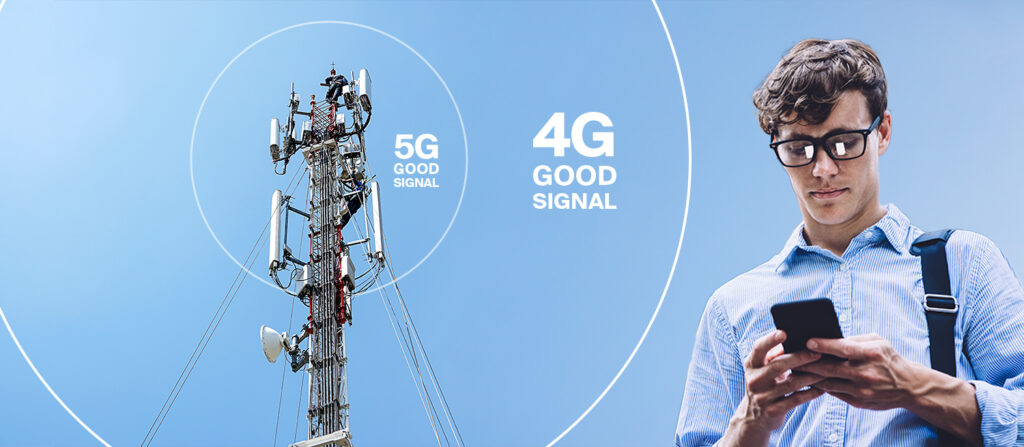In recent years 5G finally started going mainstream. After years of false starts, protests from conspiracy theorists, and low-effort rollouts, many major cities finally received 5G coverage. The biggest thing that 5G gives mobile users is the speed of home wi-fi (or better) anywhere they have a 5G signal. This could be a game-changing upgrade for many businesses, especially those that work with large files. For example, if a business uses a lot of videos in their marketing, or maybe is an online learning platform that has interactive elements that don’t work well on standard 4G and weaker connections.
But the 5G world isn’t all sunshine and roses, there are some serious caveats to 5G and whether brands should rely on it to communicate their message. On the MNO side there are reasons you will see SMS continue to be utilised by your A2P partners, even in a 5G world.
Despite the big speed advantage, there’s a lot of disadvantages to reliance upon 5G that ensure that SMS is still relevant in 2022 and beyond. Almost everyone in the world owns a device capable of receiving SMS, whereas 5G adoption is still in early stages in many countries and completely unheard of in rural communities.
We’re going to split our analysis of 5G in to three sections — Coverage, Signal and Ubiquity:
Coverage
In 2020, China achieved their 5G tower construction goal of building 700,000 towers, covering as much of the country as possible, and reached a 5G base station count of 1.6 million in 2022. With this complete, 70% of the 5G towers worldwide now reside in China. The remaining 300,000 5G towers are spread across the rest of the world, which seems like a lot until you realise there are over 6 million 4G towers, yet many rural areas struggle with 4G. If you’re in a major city in a first world country, you’re likely to be connected to a 5G tower for a decent percentage of your day, but if you live in a rural area or are in a developing nation, then you’ll be much less likely to have access to 5G.
As an example, let’s compare my home city of Bristol. A little under half a million people live there, and it’s the largest city in the southwest of England. However, with multiple universities, it’s also a relatively young city with over 10% of the population being students. Statistically, more young people should mean a higher level of smartphone adoption.
In Bristol the mobile network with the best 5G coverage is Vodafone, and according to data from RootMetrics it covered 58% of the city as of December 2021. But if you travel 30 miles down to road to my new, more rural Somerset home, there is no 5G signal at all. In fact, you can’t get a reliable 4G signal indoors in my town.
But you know what you can get pretty much everywhere in the UK? An SMS. Sure, you can’t share a large video file as part of a marketing campaign, but if you want to contact somebody and know that they will receive your message, an SMS is very unlikely to go undelivered. You can also share a URL in your SMS to that video that your prospective customer can view at a later date.
Signal
I talked earlier about how great 5G speeds can be, and if you’re in an area with 5G and you’ve got a good signal, that’s definitely the case. Unfortunately, that’s not the entire story. In this 2019 video, tech YouTuber Marques Brownlee bought a brand new $1,600 Samsung flagship smartphone, one of the first to include 5G in the mainstream world, and took it out to a nearby university that had installed 5G towers.
When standing directly underneath the tower, Brownlee gets a data download speed so fast it is off the charts — literally, the app he uses doesn’t measure that high. But when he walks a few feet down the street and around the corner, the data speed is reduced to six times less than what he had by the tower.
This is because buildings, trees, and walls more easily obstruct the frequency used to transmit data for 5G signals. It requires a clear line of sight to produce the eye-watering speeds that marketing portrays.
One other issue with 5G is the distance a single tower can cover. According to this article from Light Reading, the average range is around 500 metres. The average range for a 4G (known as LTE in the US) is much more extensive. According to this article from Solid Signal, you can be 1-2 miles from the tower for reliable service and up to 5-7 and still get a good signal.

With SMS, you don’t even need to have 4G! You can receive an SMS anywhere that your phone can connect to a tower, which can be up to 45 miles. If you’ve got something important to say to your customer, it might be worth considering where they live. Check the address details they’ve given you, and if they’re in a rural area, you will often be better off with SMS.
Ubiquity
The final problem with 5G is possibly the most relevant one. Ubiquity. For example, let’s say you live in my hometown of Bristol with its 58% 5G coverage. Your home is within 500 metres of a 5G tower, and your office is too (you’re working from home because it’s 2022). The average person in the UK keeps their phone for over two years, so you have 2019’s best selling phone, the iPhone XR. Instantly, you’re out of the 5G running. In 2020 Apple introduced 5G to their phone line-up, but the average person will only be upgrading to that around now.
Unfortunately, the above paragraphs show that you can’t always rely on somebody having access to a 5G service. But even if you know they live in an area with a great 5G signal, you can’t rely on their phone having 5G capability. But you can rely on one thing: if they have a phone, they can receive an SMS.
Why 5G won’t kill SMS for MNOs
As discussed in the previous sections — 5G is an amazing technology. However, there are still teething issues across signal strength, coverage, and ubiquity where SMS ends up being a more favourable product for brands when deploying mobile marketing campaigns. But what does this mean for MNOs?
Luckily MNOs can leverage 5G data speeds for OTT messaging and A2P SMS because they provide both. In many ways, A2P SMS is more entrenched in our lives than ever, with two way messaging for customer support becoming more and more popular and almost every popular service offering OTP secured login.

You might think that A2P SMS would reduce in volume as 5G becomes more popular, but SMS 2-factor verification is more popular than ever. Some apps and services will even require an SMS OTP every single time you login, no matter whether your device is 5G capable or not.
Next generation revenue opportunities for MNOs
5G connectivity and SMS might seem to be at odds, but actually, they will rely on each other in many cases. Take, for example, the recent proliferation of smart speakers, connected displays, smart electricity meters and other IoT (Internet of Things) devices. In many cases, those devices will run on a combination of 5G data connections and wi-fi, but how do those devices log in to your account? That’s right, one-time passwords are sent through SMS. The same is true for almost all OTT messaging apps that take advantage of 5G connections, and in fact, most apps require accounts to log in. So every time somebody upgrades to a 5G phone to take advantage of the increased data speed, there will be a flurry of SMS OTPs going out to them as they log in to apps and services for the first time.
But while consumer IoT devices will surely be a source of A2P SMS revenue for telcos, there will be significant opportunities in the enterprise space. One of the considerable strengths of IoT devices is the ability to provide data to enterprises using a cellular network. Combine this with battery or even solar power and devices like smart meters, wind trackers, thermometers, and more that can provide vital data need not rely on power or wi-fi to provide that data.
Unfortunately, a constant 5G connection is a significant drain on battery life, meaning many devices cannot maintain a constant 5G connection. A 2G connection, capable of receiving SMS, is a whole different story. These can be maintained consistently with low power devices. An excellent example of this is smart sensors for weather data. These devices are often placed outside out of easy reach for charging and such but say, for example, your company needs to pull wind speed data from a sensor, you can wake the sensor up to start transmitting data over 5G using an SMS.
Also an increase in the popularity of 5G powered OTT services for A2P messaging doesn’t necessarily cut MNOs out of the loop, as they can offer a CPaaS service to their customers to monetise that traffic.
The bright side for everyone
But it’s not all doom and gloom. 5G and SMS have something really cool in common — immediacy. With a combination of a strong 5G signal or their home/office wi-fi, you can expect anything you send to your customers to be immediate. So no buffering, no waiting around for your assets to load or for a complicated website to be ready to access.
Immediacy is also a massive pro in the column for SMS, with 90% of marketing SMS being read within 3 minutes of receipt. Even more impressive, 99% of them will be read within 20 minutes. You won’t get that with almost any other digital medium. So if you’ve got something important to say, you can rely on SMS.

